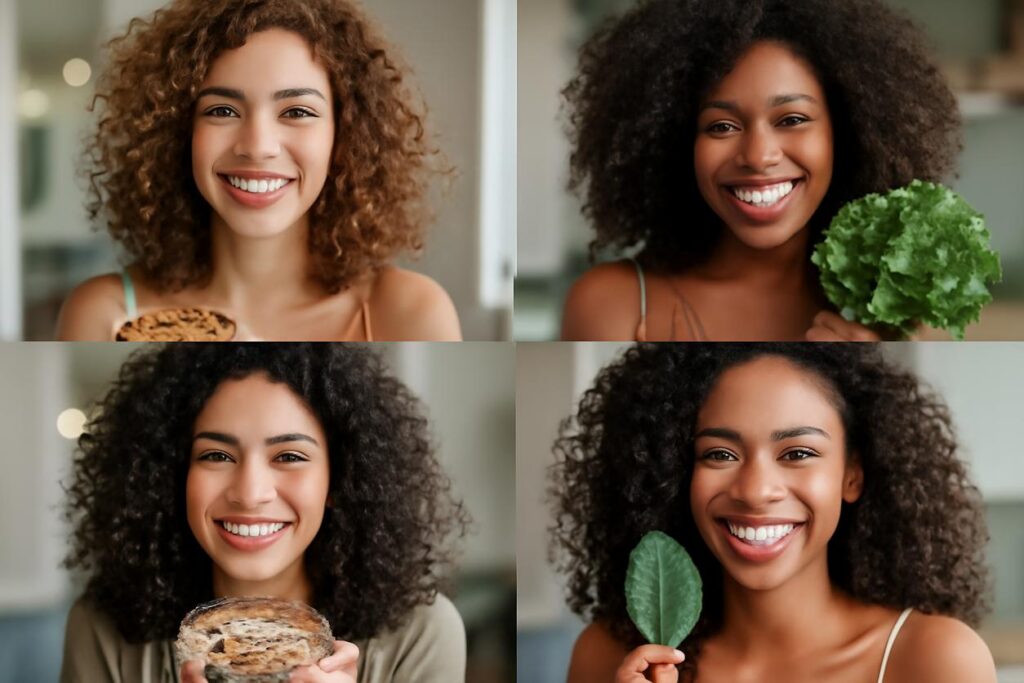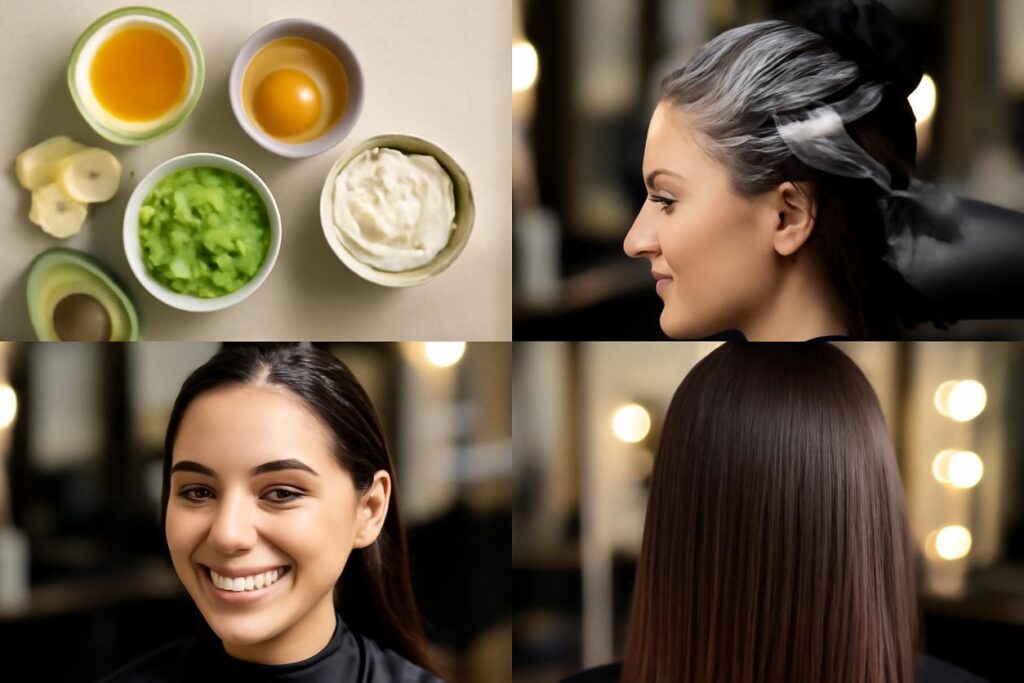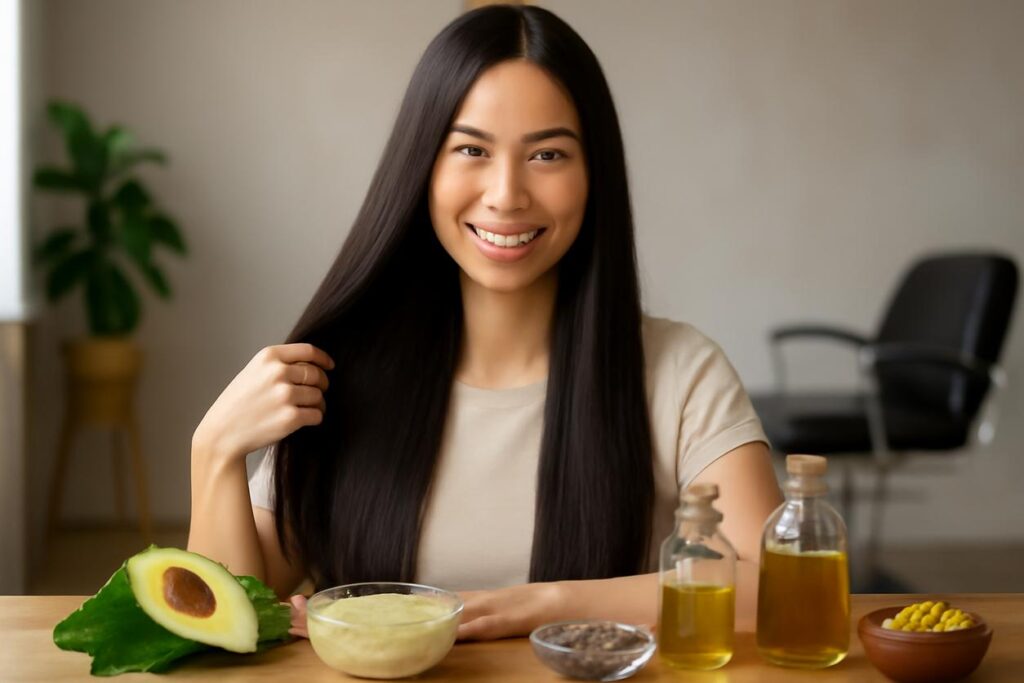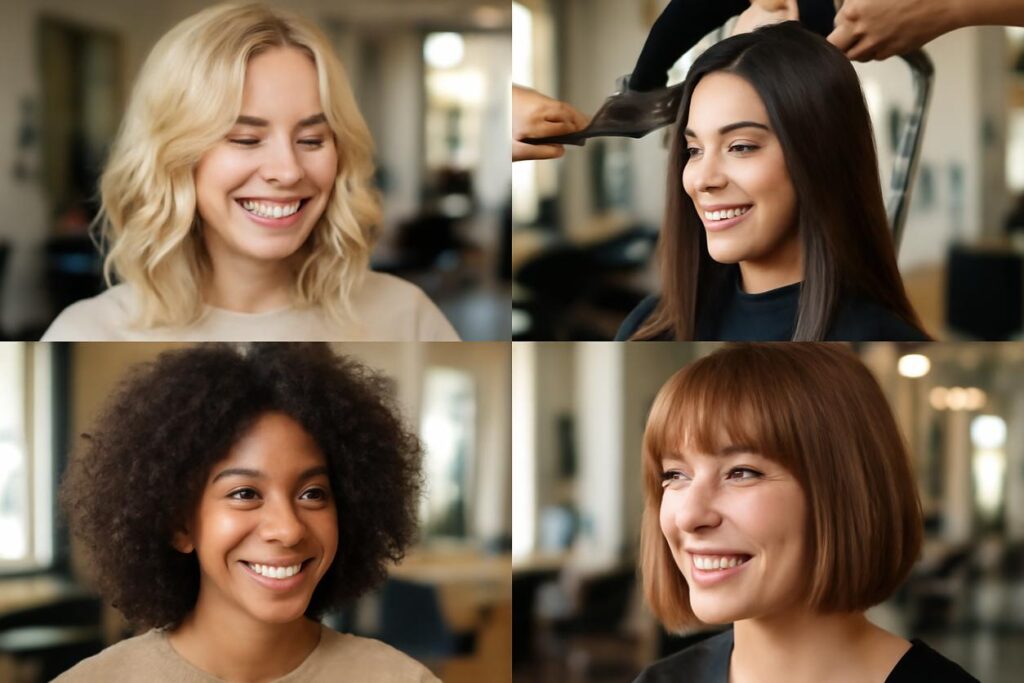The Ultimate Guide to Curly Hair Nutrition: Eat Your Way to Healthier Curls in 2025
Table of Contents
- Introduction: Why Your Curls Crave the Right Fuel
- The Building Blocks: Key Macronutrients for Resilient Curls
- The Spark Plugs: Micronutrients for Growth and Shine
- Your Personal Curl Map: Matching Nutrients to Your Hair Type
- A 7-Day Curly-Hair Nutrition Blueprint
- Smart Snacking and Pantry Swaps for Healthier Curls
- Navigating Supplements: A Cautious Approach
- Curl Saboteurs: Foods and Habits to Minimize
- Your Curl-Friendly Grocery List: Simple and Budget-Friendly Options
- Meal Prep for Success: Making Healthy Eating Easy
- Decoding Labels: How to Read Food Labels with Curl Goals in Mind
- Frequently Asked Questions About Curly Hair Nutrition
- Further Reading and Trusted Resources
Introduction: Why Your Curls Crave the Right Fuel
If you have curly hair, you know the journey is filled with a quest for the perfect routine, the holy grail product, and the secret technique for frizz-free definition. But what if the most powerful tool for transforming your curls wasn’t in your bathroom cabinet, but in your kitchen pantry? The world of curly hair nutrition is a game-changer, focusing on building strong, hydrated, and resilient hair from the inside out. The food you eat directly provides the building blocks for every strand on your head.
How Curl Structure and Porosity Shape Nutritional Needs
Unlike straight hair, the hair shaft of a curl has a unique elliptical shape and twists and turns. This structure causes the cuticle layers (the protective outer shell of the hair) to lift, making it harder for natural scalp oils (sebum) to travel down the strand. This is why curly hair is naturally prone to dryness and frizz.
Furthermore, hair porosity—your hair’s ability to absorb and retain moisture—plays a huge role.
- Low Porosity: Tightly bound cuticles that resist moisture. Hair can be prone to product buildup.
- Medium Porosity: Cuticles are looser, allowing moisture in and out at a balanced rate.
- High Porosity: Gaps and holes in the cuticle layer let moisture in easily but lose it just as fast. This hair type is often dry, frizzy, and fragile.
Understanding your curl pattern and porosity helps you understand why a personalized approach to curly hair nutrition is so effective. High-porosity hair might crave more healthy fats to seal its cuticles, while low-porosity hair needs efficient hydration and easily absorbed proteins.
The Building Blocks: Key Macronutrients for Resilient Curls
Think of macronutrients as the primary construction crew for your hair. Without them, you can’t build strong, healthy strands.
Protein: The Foundation of Strong Strands
Your hair is made of about 95% protein, specifically a fibrous protein called keratin. When your diet lacks sufficient protein, your body prioritizes essential functions, and hair growth can be one of the first things to suffer. A lack of protein can lead to brittle, weak hair that breaks easily. Incorporating high-quality protein sources is non-negotiable for robust curls.
- Animal Sources: Lean meats, poultry, fish, eggs, and dairy.
- Plant-Based Sources: Lentils, beans, tofu, tempeh, quinoa, and nuts.
Healthy Fats: Your Curls’ Best Friend for Moisture
Healthy fats, particularly omega-3 fatty acids, are crucial for maintaining a healthy scalp and producing the natural oils that moisturize your hair. They support the cell membranes of your scalp’s follicles and help add shine, elasticity, and luster to your curls. A diet low in healthy fats can result in a dry, flaky scalp and dull, lifeless hair.
- Excellent Sources: Salmon, mackerel, avocados, nuts (especially walnuts), seeds (flax, chia), and olive oil.
Hydration: The Unsung Hero of Elasticity
Water is perhaps the most overlooked component of curly hair nutrition. Proper hydration is essential for overall health, and that includes your hair. Dehydration can halt hair growth and make strands brittle and dry from the inside. Water helps your body absorb all the other wonderful nutrients you’re consuming. Aim for consistent water intake throughout the day to keep your curls supple and elastic.
The Spark Plugs: Micronutrients for Growth and Shine
If macronutrients are the construction crew, micronutrients are the specialized tools and electrical wiring that make everything work correctly.
Essential Vitamins for a Healthy Scalp and Hair
- Biotin (Vitamin B7): Famous for its role in hair health, biotin is essential for producing keratin. Found in eggs, almonds, and sweet potatoes.
- Vitamin C: A powerful antioxidant that helps protect against free radical damage. It’s also crucial for creating collagen, a protein that strengthens hair. Find it in citrus fruits, bell peppers, and strawberries.
- Vitamin A: Helps scalp glands produce sebum, the natural conditioner for your hair. Sweet potatoes, carrots, and spinach are rich sources.
- Vitamin E: Another antioxidant that supports a healthy scalp and can improve hair growth. Found in sunflower seeds, almonds, and avocados.
- Vitamin D: Can help create new follicles, the tiny pores where new hair can grow. Sunlight is a primary source, but it’s also in fatty fish and fortified foods.
Key Minerals That Make a Difference
- Iron: An iron deficiency (anemia) is a major cause of hair loss. Iron helps red blood cells carry oxygen to your follicles, which is essential for growth. Find it in red meat, spinach, and lentils.
- Zinc: Plays a vital role in hair tissue growth and repair. It also helps keep the oil glands around the follicles working properly. Oysters, beef, pumpkin seeds, and lentils are great sources.
- Selenium: An important trace mineral that helps protect the body from oxidative damage and plays a role in hair production. Brazil nuts are an incredibly potent source.
Your Personal Curl Map: Matching Nutrients to Your Hair Type
Tailoring your curly hair nutrition to your hair’s specific needs can accelerate your results. Here’s a simple guide.
For Fine or Low-Porosity Curls
Your hair gets weighed down easily. Focus on nutrients that strengthen without adding excess oil.
- Focus On: Lean proteins (chicken breast, fish, tofu), easily digestible fats (avocado, olive oil), and water-rich foods (cucumbers, watermelon).
- Nutrient Highlight: Silica, found in bananas, oats, and green beans, helps build strand strength without heaviness.
For Medium or Normal-Porosity Curls
Your goal is maintenance and balance. A well-rounded diet is your best strategy.
- Focus On: A balanced mix of all macronutrients. Ensure a consistent intake of protein (eggs, Greek yogurt), healthy fats (salmon, walnuts), and complex carbs (quinoa, sweet potatoes).
- Nutrient Highlight: Zinc is excellent for keeping oil glands functioning perfectly. Pumpkin seeds are an easy way to get more.
For Coarse or High-Porosity Curls
Your hair is thirsty and needs help sealing in moisture and repairing its structure.
- Focus On: Richer proteins (lean red meat, lentils) and an abundance of healthy fats to help seal the cuticle. Omega-3s are your superstar.
- Nutrient Highlight: Vitamin E and healthy fats from sources like sunflower seeds and avocados help protect and moisturize damaged, porous strands.
A 7-Day Curly-Hair Nutrition Blueprint
Here is a sample week-long meal plan designed to incorporate a variety of hair-loving nutrients. Adjust portions based on your individual needs.
| Day | Breakfast | Lunch | Dinner |
|---|---|---|---|
| Monday | Scrambled eggs with spinach and a side of whole-wheat toast. | Quinoa salad with chickpeas, cucumber, bell peppers, and a lemon-tahini dressing. | Baked salmon with roasted asparagus and sweet potato. |
| Tuesday | Greek yogurt with berries, chia seeds, and a handful of walnuts. | Lentil soup with a side salad. | Chicken stir-fry with broccoli, carrots, and brown rice. |
| Wednesday | Oatmeal made with milk or a fortified alternative, topped with banana and flaxseeds. | Leftover chicken stir-fry. | Turkey meatballs in a tomato sauce with zucchini noodles. |
| Thursday | Smoothie with spinach, avocado, protein powder, and almond milk. | Tuna salad (made with Greek yogurt) sandwich on whole-grain bread. | Black bean burgers on a whole-wheat bun with a side of sweet potato fries. |
| Friday | Whole-grain toast with avocado and a sprinkle of pumpkin seeds. | Large salad with grilled chicken, mixed greens, and a variety of vegetables. | Homemade pizza on a whole-wheat crust with lots of veggies. |
| Saturday | Pancakes made with whole-wheat or oat flour, topped with fresh fruit. | Leftover pizza or a large salad. | Lean steak or grilled tofu with roasted Brussels sprouts and quinoa. |
| Sunday | Omelet with bell peppers, onions, and a small amount of cheese. | Bean and vegetable chili. | Roast chicken with a medley of root vegetables (carrots, parsnips). |
Smart Snacking and Pantry Swaps for Healthier Curls
Small changes can make a big impact on your curly hair nutrition journey.
Quick Snack Ideas
- A handful of almonds or walnuts.
- An apple with a spoonful of nut butter.
- Greek yogurt with a sprinkle of chia seeds.
- Hard-boiled eggs.
- Baby carrots with hummus.
- A single Brazil nut (for your daily dose of selenium).
Simple Pantry Swaps
- Swap white rice and pasta for brown rice and whole-wheat pasta.
- Swap sugary cereals for oatmeal or a low-sugar, high-fiber option.
- Swap vegetable oil for olive oil or avocado oil for cooking.
- Swap potato chips for air-popped popcorn or a handful of nuts.
Navigating Supplements: A Cautious Approach
While a food-first approach is always best, supplements can sometimes be useful for filling specific nutritional gaps.
When to Consider Supplements
Consider supplements only after consulting with a healthcare professional, especially if you:
- Have a known deficiency (like iron or Vitamin D), confirmed by a blood test.
- Follow a restrictive diet (e.g., veganism, which may require B12 supplementation).
- Are experiencing significant, unexplained hair shedding.
How to Evaluate Them
Look for third-party certifications (like NSF or USP) on the label, which verify that the product contains what it says it does. Be wary of “hair growth” gummies that are often high in sugar and low in effective dosages of key nutrients.
Curl Saboteurs: Foods and Habits to Minimize
Just as some foods help your curls thrive, others can undermine their health.
- Excessive Sugar: High-sugar diets can cause inflammation, which can negatively impact the scalp and hair follicles.
- Highly Processed Foods: These are often low in essential nutrients and high in unhealthy fats and refined carbohydrates.
- Crash Dieting: Drastically cutting calories can deprive your body of the protein, vitamins, and minerals needed for hair growth.
- Excessive Alcohol: Alcohol can be dehydrating and can deplete your body of key nutrients like zinc.
Your Curl-Friendly Grocery List: Simple and Budget-Friendly Options
Healthy eating doesn’t have to be expensive. Focus on whole foods.
- Proteins: Eggs, canned tuna/salmon, lentils, beans (canned or dried), tofu, Greek yogurt.
- Healthy Fats: Olive oil, avocados, nuts and seeds (buy in bulk for savings).
- Vegetables: Spinach, broccoli, carrots, sweet potatoes, bell peppers (buy in-season or frozen).
- Fruits: Bananas, apples, oranges, berries (frozen is a great budget option).
- Complex Carbs: Oats, brown rice, quinoa, whole-wheat bread.
Meal Prep for Success: Making Healthy Eating Easy
Consistency is key for seeing results. Meal prepping makes sticking to your curly hair nutrition plan much easier.
- Cook in Batches: Make a large batch of quinoa, brown rice, or roasted vegetables at the start of the week.
- Portion Snacks: Divide nuts, seeds, and chopped veggies into grab-and-go containers.
- Pre-Chop Veggies: Wash and chop vegetables like onions and peppers so they are ready for stir-fries or omelets.
- Make Mason Jar Salads: Layer dressing on the bottom, followed by hard veggies, grains, protein, and greens on top to keep them fresh.
Decoding Labels: How to Read Food Labels with Curl Goals in Mind
Don’t let confusing labels derail your efforts. Focus on a few key areas:
- Ingredients List: The ingredients are listed by weight. Look for whole foods at the top of the list. If sugar is one of the first few ingredients, it might not be the best choice.
- Added Sugars: Check the “Nutrition Facts” panel for “Added Sugars.” Aim to keep this number as low as possible.
- Protein and Fiber: For packaged goods like bread or snacks, look for options with a few grams of protein and fiber per serving to help keep you full and your blood sugar stable.
Frequently Asked Questions About Curly Hair Nutrition
How long does it take to see results from changing my diet?
Hair grows about half an inch per month. Since you are nourishing the new hair growing from the follicle, it can take 3 to 6 months to notice a significant difference in the strength, shine, and health of your new growth.
Can nutrition fix my split ends?
No. Nutrition can prevent future damage and breakage, but it cannot repair existing split ends. The only way to get rid of them is to get a trim. A healthy diet will ensure the hair that grows in is much more resilient to splitting.
Is a vegetarian or vegan diet good for curly hair?
Absolutely! A well-planned vegetarian or vegan diet can be excellent for hair health. The key is to be diligent about getting enough protein (from lentils, beans, tofu), iron (from leafy greens and legumes, paired with Vitamin C for absorption), zinc (from seeds and beans), and potentially supplementing with Vitamin B12.
Further Reading and Trusted Resources
For those who want to dive deeper into the science of nutrition and hair health, these sources provide reliable, evidence-based information.
- Hair Nutrition Research: A database of scientific studies on various health topics.
- Nutrient Reference Data: Detailed fact sheets on vitamins and minerals from the National Institutes of Health.
- Protein and Hair Health Review: Scientific articles exploring the link between diet and hair health.
- Nutrition and Hydration Guidelines: Global health recommendations from the World Health Organization.






